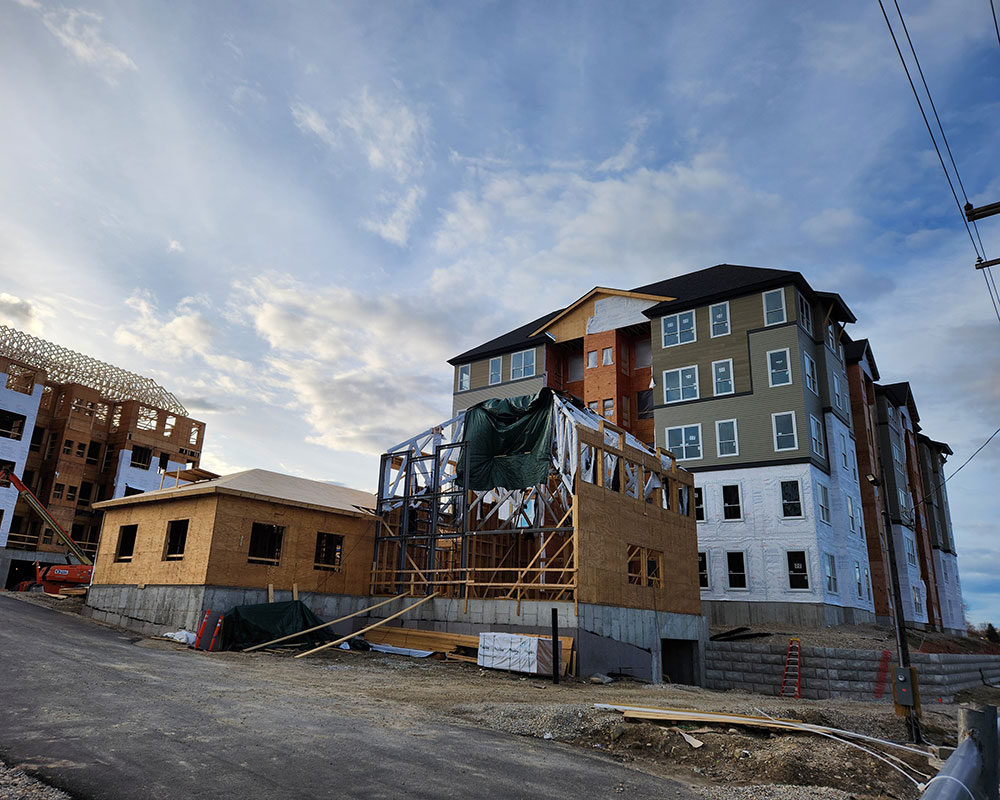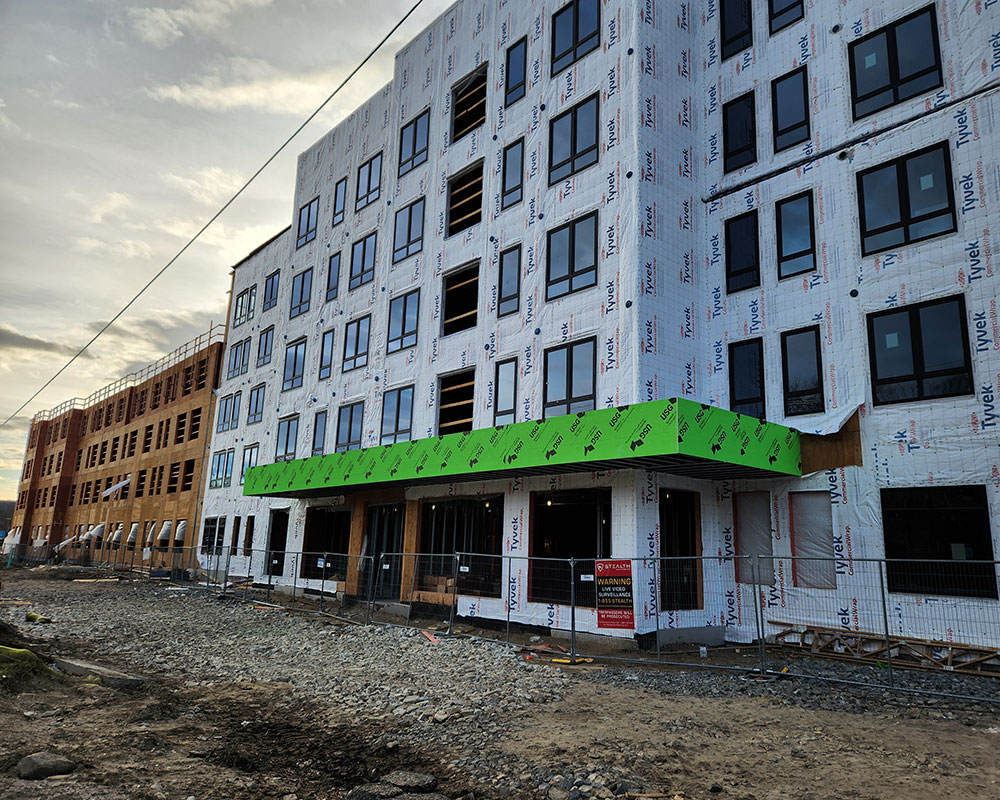(Additional photograph below.)
Part 2 of an occasional series.
State officials report a housing shortage as demand far outstrips supply. In Haverhill, some residents wonder where they fall in the city’s priorities after development has increased in recent years. In light of a contentious zoning board meeting in January, a WHAV series explores concerns raised about impacts on the environment, overdevelopment with insufficient infrastructure and the character of long-settled neighborhoods changing.
A group of longtime residents walked through their neighborhood, the Wood School area, on a beautiful February day, stopping every so often to point out, in their eyes, yet another infrastructure eyesore—improperly installed gas lines, large cracks in the road from improper drainage, and neighbors’ yards and basements that flood when it rains.
“The way things are not maintained,” Paul McElroy said. “It’s horrible, and it hasn’t changed one iota since we’ve lived here, and we’ve lived in the whole city for—”
Lisa McElroy, his wife, chimed in, “I’ve lived here for almost 37 years, and all I see is more buildings being built, more buildings being built, but not the proper infrastructure.”
The McElroys and other neighbors had successfully reduced a nearby development from four homes to three at a zoning board meeting in January. Yet Paul McElroy said he remains concerned about further residential development in the rest of the city, which raises questions he does not think have been adequately considered.
“They’re building everywhere,” McElroy said. “Where’s everybody going to school? Where’s all that new money going to come from? And then, where do we sit? [Where] in the line of importance do we now fall? Because now all these people are moving here, and they need more schools, then they need more police, they need more fire because they’re just putting more and more out.”
According to City Economic Development and Planning Director William Pillsbury Jr., the city has put careful controls on residential development, saying the government is waiting for the completion of projects currently underway, and for their units to be “absorbed” by the housing market, before allowing further construction. He added that the mayor’s office has made it a priority to ensure existing infrastructure can handle new developments.
In part 1 of this series, City Engineer John H. Pettis III noted improvements to roads and drainage systems are often very expensive, estimating that alleviating flooding in the Wood-School area would cost “tens of millions.”
“It’s vital to hear from the neighbors. It’s one of the fundamental premises of America—is that you hear from the neighbors and the neighbors have their input,” Pillsbury said. “Where we are right now, and this isn’t just Haverhill, you look at what’s going on in Milton… There’s a real strong pushback from neighbors on too much growth, and it’s time to stop, it’s time to slow down.”
Milton residents recently voted down their town government’s plan for denser zoning after the state began requiring multifamily districts in communities serviced by the Massachusetts Bay Transit Authority in 2021. The state has responded by taking away grants and Attorney General Andrea Joy Campbell has filed suit against the town. Haverhill already complies because of its downtown zoning, according to Pillsbury.
The City Council must sign off on any project larger than two units, weighing input from city departments and neighbors, bringing “technical” information into a “political environment,” as Pillsbury put it.
“Ultimately there’s a lot of room, generally, in the public hearing process, room for the neighbors to be heard, and for their perspectives to be brought forward to the project as well,” he said. “In a lot of cases, that determines the outcome.”
Taking Stock of Haverhill’s Housing
Around 1,300 new housing units are at different stages of permitting and construction, according to Pillsbury. These include 290 units in “The Beck,” 153 units at the site of the former DiBurro’s Function Hall and 370 to 420 rentals in a new complex downtown as of a plan from 2022. “The Beck” and the downtown development, proposed by developer Salvatore N. Lupoli, also promise retail areas.
Pillsbury said the city government aims to concentrate new development in “village centers,” following a 2020 master plan update called “Vision Haverhill 2035.” This was the first change to the plan since 1995. It aims to strengthen the city’s tax base—without unduly burdening residents—by bringing in more industry and retail.
Former Mayor James J. Fiorentini said during the plan’s 2020 unveiling, “Smart growth, used successfully in cities throughout the country, allows for small clusters, or villages, to be built in certain areas of a city that will allow people to live and walk to a local center. The zoning allows for residential growth, while preserving the look and feel of the city that the master plan’s focus groups said is critical to the public.”
Most of the 1,300 new units in Haverhill are set to be studios, one- and two-bedrooms—not suitable for families, Pillsbury said. Ian Burns, who works for the Merrimack Valley Planning Commission, said it is a common misconception new units like these will bring more children to a city. Overcrowding exists, Burns said, but greater supply in a city allows families already living in Haverhill to escape such conditions, with new stock providing the opportunity for some members to move out.
According to Burns, 978 units in multifamily developments were permitted from 2000-2020. At the same time, public school enrollment decreased by around 13%. A graph from “Vision Haverhill 2035” shows, while there has been a decrease from 2000 to 2020, enrollment has ticked up in recent years, though it remains below the level in 2000, as Burns pointed out. Since 2020, when the master plan was last updated, the state’s Department of Elementary and Secondary Education reports enrollment has dropped from 8,063 in 2020 to 7,882 in 2024.
In the last four years, the number of Hispanic and Latino students has grown by around 500, while the number of white students has shrunk by roughly 800, according to the state education department.
With so few units available in Haverhill, more housing at all price levels helps, Burns said. One of McElroy’s neighbors, Dave Gaiero, also helped form the group that went to the zoning board meeting. Gaiero acknowledged that there is a housing shortage in the city, particularly of affordable units, but said he does not think the two duplexes discussed at the January meeting would do anything to help because of their high cost.
Burns explained however, housing stock in a city functions as a chain. If the duplexes were built, higher earners would move in, freeing up the unit they had moved out of. In a tight housing market, higher-income people often occupy lower-quality housing stock than they would prefer, moving into higher-price living spaces only if they become available. They often compete with lower earners for the same housing, pushing up the prices of these units and making them unaffordable.
On top of that, multifamily developments grow a city’s tax base, Burns said, taking some of the burden off of homeowners like the McElroys and Gaieros.
Only a few members of the Board of Appeals voted in favor of the variance Wood School residents opposed during the January meeting. One was Kassie Infante, who serves as associate director of operations at Abundant Housing Massachusetts.
“A couple of years ago, Boston University did this study on, who are the folks that typically turn out to object [to] new housing opportunities in their neighborhood,” she said.” What that study found is that those folks tend to not be representative of the larger community. They tend to skew older, white—in terms of racial, ethnic demographic—and homeowner. And so, not a lot of renters [or] lower-income people of color.”
She called her work at Abundant Housing the “antithesis to that.” Though she said she understood Haverhill residents’ pain at losing places that were essential to their lives in the city—like the DiBurro’s Function Hall and potentially the miniature golf course at Cedardale—she said fear of change should not outweigh the urgent need for housing.

Construction of 153 apartments on the site of the former DiBurro’s Function Facility, off Route 125 in Ward Hill. (WHAV News photograph.)
